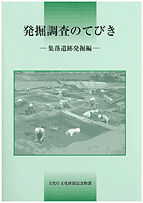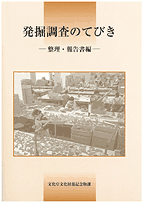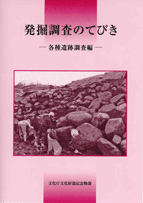What are Buried Cultural Properties?
Buried Cultural Properties are cultural properties that lie underground (known as archaeological sites). There are approximately 460,000 sites in Japan that are known to have Buried Cultural Properties (Areas Known to Have Buried Cultural Properties). Every year, about 9,000 excavations are performed for investigative purposes.
Buried Cultural Properties and the Act on the Protection of Cultural Properties
Under the Act on the Protection of Cultural Properties, notification must be submitted to the Board of Education of prefectures or designated cities when starting construction work in an Area Known to Have Buried Cultural Properties (Article 93 and 94). Notification must also be submitted when archaeological sites are discovered (Article 96 and 97). Unearthed finds (artifacts) must be submitted to the chief of the governing police station by the finder except in cases where the owner is obvious (Article 100).
Upon receiving notification of construction projects, the Board of Education of the prefecture or designated city will decide how to handle the cultural properties. When it is impossible to preserve the site's present state after mutual consultation, developers are asked to carry out the excavation and investigation for recording and cover necessary expenses. However, when it is not appropriate to ask the owner to cover the cost of the excavation, as in the case where individuals build houses for nonprofit purposes, investigations may be conducted with public funds from the National Treasury.
Handling of Artifacts
When an object is unearthed as a result of an excavation, the finder must turn it over to the chief of police. If the object is recognized as a potential cultural property, the Board of Education at the prefecture, designated city, or core city will investigate whether an object is a cultural property. An object recognized as a cultural property that has no known owner reverts to the prefecture as a rule.
Public Display of Buried Cultural Properties
Buried Cultural Properties are invaluable common assets of the people of Japan. They need to be well preserved and made publicly available. The results of investigative excavation of Buried Cultural Properties are now publicly displayed in different parts of Japan. In 1995, the Agency for Cultural Affairs launched an annual nationwide exhibition tour, "Exhibition of Excavations in the Japanese Archipelago: Bulletin of Archaeological Discovery" to display the results of investigative excavations that had drawn attention throughout Japan.
Protecting Buried Cultural Properties
While recent social changes have raised expectations for Buried Cultural Properties, 9,000 investigative excavations are carried out annually in response to widespread urban and residential development projects. Addressing the needs for a framework to protect Buried Cultural Properties, for proper and smooth excavation, and for effective preservation and utilization of unearthed ruins and artifacts, the Agency for Cultural Affairs established the "Research Committee on the Reinforcement of Buried Cultural Properties Investigative Excavation System" to discuss issues around Buried Cultural Properties and report results. Local governments have preserved and utilized Buried Cultural Properties based on these results.
Hakkutsuchosa no tebiki (Handbook for Investigative Excavation) − Excavation of Settlement Ruins / Sorting out and Reporting / Investigation of Ruins
Investigative excavations are expected to reveal the existence of buried ruins and artifacts and the mutual relationships between them, and provide an opportunity to understand their significance to local history. This requires highly knowledgeable and skilled excavation staff and the development of a robust excavation system.
To standardize the investigative excavation, the Agency published Hakkutsuchosa no tebiki (Handbook for Investigative Excavation) − Excavation of Settlement Ruins / Sorting out and Reporting in March 2010. This series aims to ensure that investigative excavation throughout Japan meets certain standards and shows the thought process, methods, and procedures in the process from excavation work, sorting of the finds, and development of reports.
A new addition to the series in March 2013, Hakkutsuchosa no tebiki (Handbook for Investigative Excavation) − Investigation of Ruins provided guidelines for methods specific to different types of archaeological remains, ranging from tombs, temples, government buildings, and castles to production sites.

Hakkutsuchosa no tebiki (Handbook for Investigative Excavation)
− Excavation of Settlement Ruins−
Hakkutsuchosa no tebiki (Handbook for Investigative Excavation)
− Sorting and Reporting −
Hakkutsuchosa no tebiki (Handbook for Investigative Excavation)
− Investigation of Ruins −
Research on Underwater Ruins
After the Takashima Kozaki archaeological site was designated a Historic Site on March 27, 2012, the Agency for Cultural Affairs began research, preservation, and utilization of underwater ruins. The Agency formed an advisory committee on the research of underwater ruins on March 22, 2013 and commissioned the Kyushu National Museum to conduct research projects on the protection of underwater ruins inside and outside Japan.
Briefing on Administration for the Protection Buried Cultural Properties
The number of experts in Buried Cultural Properties reached 7,111 at its peak in 2000. However, the number is decreasing (5,853 in May 2014) as development projects have downsized with economic stagnation and administrative reform. In recent years, to address the generational imbalance caused by this decrease, new experts have begun to be recruited throughout Japan.
The Agency's "Research Committee on the Reinforcement of Buried Cultural Properties Investigative Excavation System" responded to this trend by recommending the creation of opportunities for local governments and universities to act as places for building greater capacity, in the Agency's responsibility in the 2014 report, "Building a System for Proper Administration of Buried Cultural Properties." The Agency will start working with universities with archaeological research labs in fiscal 2015 to cultivate undergraduate and graduate students' future potential in this field, and provide opportunities for students to learn the details and attractions of administration for the protection of Buried Cultural Properties.







